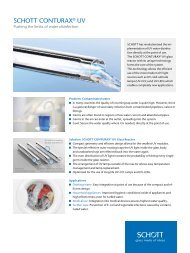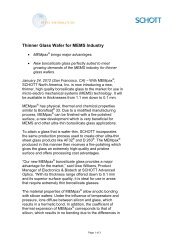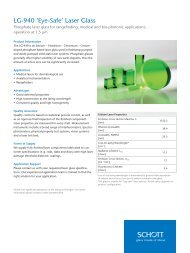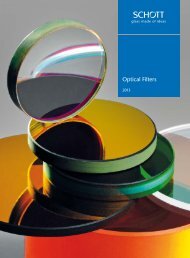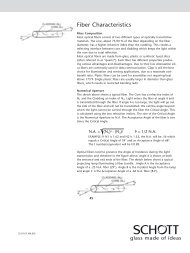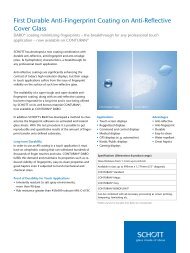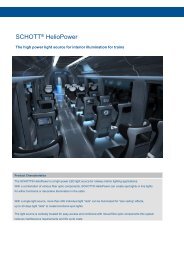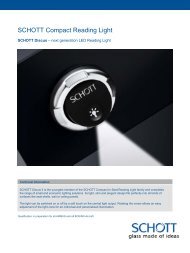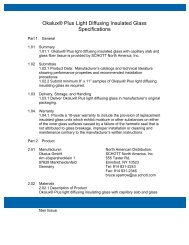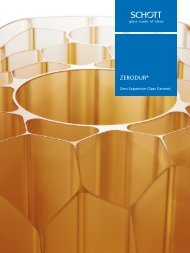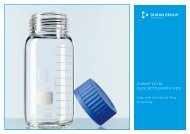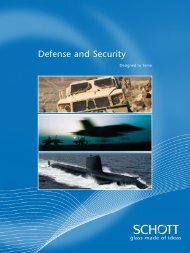- Page 1 and 2:
MV Machine Vision General Catalog I
- Page 3 and 4:
Your Global Lighting and Imaging Al
- Page 5 and 6:
New Products LED Illumination MCV-L
- Page 7 and 8:
Square Bar Type Illumination BAQ Si
- Page 9 and 10:
Selection flowchart Identify object
- Page 11 and 12:
LED Illumination MC V- Light Series
- Page 13 and 14:
R-32X10-70R (B,W) R-42X18-65R (B,W)
- Page 15 and 16:
Low Angle Ring Illumination RLA/RLA
- Page 17 and 18:
RLA Series Sample Images Chamfer Ch
- Page 19 and 20:
Lineup of Shadowless Ring Type LEDs
- Page 21 and 22:
Relative Intensity 1.2 1.0 0.8 0.6
- Page 23 and 24:
BA-42X15R (B,W) BA-74X27R (B,W) 4-M
- Page 25 and 26:
BAQ-108X108R (B,W) BAQ-148X148R (B,
- Page 27 and 28:
CX-75X46X40R (B,W) CX-94X60X58R (B,
- Page 29 and 30:
FL-27X27R (B,W) FL-51X51R (B,W) 27
- Page 31 and 32:
Cable ECB, BCB Series Extension Cab
- Page 33 and 34:
LED Illumination MG -Wave Series Be
- Page 35 and 36:
70° 75° MDRL-CR (CG,CB,CW) 10 MDR
- Page 37 and 38:
120° 70° 1 2 3 4 Direct Ring Illu
- Page 39 and 40:
Low Angle Ring Illumination MLRL Se
- Page 41 and 42:
1 234 MLRL-CR (CG,CB,CW) 23 MLRL-CR
- Page 43 and 44:
Lineup of Shadowless Ring Type LEDs
- Page 45 and 46:
Bar Illumination MBRL Series ••
- Page 47 and 48:
Square Bar Type Illumination MDQL S
- Page 49 and 50:
MDML-CR (CG,CB,CW) 50 45° 4-M3 Dep
- Page 51 and 52:
MSCL-CR (CG,CB,CW) 24 MSCL-CR (CG,C
- Page 53 and 54:
MDBC-CR(CG, CB, CW) 60 MDBC-CR(CG,
- Page 55 and 56:
MDBL-CR (CG,CB,CW) 25 MDBL-CR (CG,C
- Page 57 and 58:
MEBL-CR (CG,CB,CW) 25 MEBL-CR (CG,C
- Page 59 and 60:
IR Illumination IR Series • Provi
- Page 61 and 62:
MCEL-CIR8-2 MCEL-CIR8-940 ø6 (Ligh
- Page 63 and 64:
) MDRL-CUV31 MBRL-CUV7530 MBRL-CUV7
- Page 65 and 66:
MEBL-CRGB25-3CH MBRL-CRGB7530-3CH 1
- Page 67 and 68:
MBRC-CR(CG,CB,CW) * *12-DF 12 (Ligh
- Page 69 and 70:
Length Standard Type Reflective Typ
- Page 71 and 72:
MLNX-CR(CG,CB,CW) * *-DF Line Lengt
- Page 73 and 74:
LED Spot Projectors IP67 MSPP Serie
- Page 75 and 76:
Intensity and Lighting Area Range *
- Page 77 and 78:
High Power LED Spot Illumination Mo
- Page 79 and 80:
Spectral Characteristic Data 1.2 1.
- Page 81 and 82:
Condenser Lenses for Spot Illuminat
- Page 83 and 84:
A080W Analog Series Model MLEK-A080
- Page 85 and 86:
C O R P O R A T I O N MLEK-D770W4LR
- Page 87 and 88:
MLEX-A600W1 COARSE FINE REMO POWER
- Page 89 and 90:
A035W Analog Series Model MLEP-A035
- Page 91 and 92:
Options for MG-Wave Series Options
- Page 93 and 94:
Illumination Lens Options •• Us
- Page 95 and 96:
LED Illumination Data MORITEX measu
- Page 97 and 98:
Fiber Optic Light Sources and Light
- Page 99 and 100:
LLS 2 - LED Light Source A 256 Unit
- Page 101 and 102:
Halogen Light Sources 150 W RoHS CE
- Page 103 and 104:
RS-485 Communication Unit MCGA-204D
- Page 105 and 106:
Light Source Equipment Options Ligh
- Page 107 and 108:
i-107
- Page 109 and 110:
MRP30-1500V Minimum Bend R=40 L=150
- Page 111 and 112:
+50 0 Bifurcated Light Guides •
- Page 113 and 114:
Plate Type Light Guides •• Thes
- Page 115 and 116:
Condenser Lenses for Line Light Gui
- Page 117 and 118:
Ultra-Uniform Fiber Illumination MF
- Page 119 and 120:
0 0 For Straight/ Bifurcated/ Multi
- Page 121 and 122:
System Chart for Ring Light Guides
- Page 123 and 124:
Transmittance Rate and Luminosity D
- Page 125 and 126:
Fiber Optic Light Sources and Light
- Page 127 and 128:
LLS - LED Light Source Dimensions i
- Page 129 and 130:
DCR ® III Light Source Dimensions
- Page 131 and 132:
DCR ® III Plus Light Source Dimens
- Page 133 and 134:
DCR ® IV Light Source Dimensions i
- Page 135 and 136:
i-135
- Page 137 and 138:
ACE ® Light Source Dimensions in (
- Page 139 and 140:
ACE ® Remote Light Source Dimensio
- Page 141 and 142:
Halogen Lamps & Modulamp Assemblies
- Page 143 and 144:
RS232 Interface Dimensions in ( ) a
- Page 145 and 146:
RS232 Interface Dimensions in ( ) a
- Page 147 and 148: Universal Ringlights Dimensions in
- Page 149 and 150: DCR ® III Light Source Ringlight I
- Page 151 and 152: Ringlights, 66mm Dimensions in ( )
- Page 153 and 154: Ringlights, 58mm Dimensions in ( )
- Page 155 and 156: Darkfield Illuminator / Ringlight A
- Page 157 and 158: Ringlight Adapters Dimensions in (
- Page 159 and 160: Diffuse Dome For use with 4” Fibe
- Page 161 and 162: For accurate positioning when using
- Page 163 and 164: Single Bundles Ringlight Input: Bla
- Page 165 and 166: Dual and Quad Bundles Ringlight Inp
- Page 167 and 168: Randomized and Calibrated Bundles R
- Page 169 and 170: i-169
- Page 171 and 172: Single and Dual Goosenecks Ringligh
- Page 173 and 174: Combination Goosenecks & Bundles Ri
- Page 175 and 176: Support Apparatus Articulated Arm,
- Page 177 and 178: Filters, Diffusers & Spot Lenses Di
- Page 179 and 180: Lightlines, 1", 2", & 3" Input: Bla
- Page 181 and 182: Lightlines Dimensions in ( ) are in
- Page 183 and 184: Spatially Randomized Lightlines Inp
- Page 185 and 186: Lightline Lenses Cylindrical and ap
- Page 187 and 188: Lightlines Support Apparatus A08901
- Page 189 and 190: Single and Dual Backlights Input: B
- Page 191 and 192: PANELite ® Backlights Dimensions i
- Page 193 and 194: i-193
- Page 195 and 196: W Fiber Material: Characteristics:
- Page 197: The calculated minimum NA. required
- Page 201 and 202: Quartz UV Light Guides Our Quartz f
- Page 203 and 204: Quartz UV Light Guide Options Unit
- Page 205 and 206: i-205
- Page 207 and 208: Fused Fiber Bundle Termination: The
- Page 209 and 210: Catalog Icon Key CE UL CSA RoHS IP6
- Page 211 and 212: Product Category Page MF MFKG / Lon



